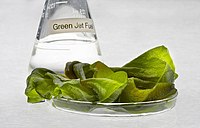
Photo from wikipedia
Opportunities associated with biomass production and bioproduct isolation from algae-derived feedstocks are plentiful and promising; however, there are challenges associated with realizing these applications. One of the most important, and… Click to show full abstract
Opportunities associated with biomass production and bioproduct isolation from algae-derived feedstocks are plentiful and promising; however, there are challenges associated with realizing these applications. One of the most important, and often overlooked, challenges is the lack of availability of a strong foundation of compositional analysis methods validated on microalgal biomass. Currently, compositional analysis in algae is dominated by the use of interference-prone methods, a lack of full mass balance accounting, and the use of top-down approaches that bin all unaccounted-for mass into a single category, such as carbohydrates. We present here an approach based on a bottom-up algal biomass characterization aimed at moving towards, and highlighting the importance of, full and accurate mass closure to achieve the maximum economic potential from a sustainable and renewable feedstock. Algal biomass representing three genera, Nannochloropsis, Scenedesmus, and Monoraphidium, was subjected to a cell rupture and fractionation process, followed by detailed characterization of each fraction to determine the partitioning of measured and unknown components. The goal of this work is to identify where the missing components partition, and develop a strategy to close the mass balance or identify the unknowns, while utilizing a rigorous characterization approach for characterizing algal biomass. Although only 75–80% of the biomass was accounted for, the fractionation approach utilized here provides key insight into possible chemical components for future investigations.
Journal Title: Journal of Applied Phycology
Year Published: 2021
Link to full text (if available)
Share on Social Media: Sign Up to like & get
recommendations!